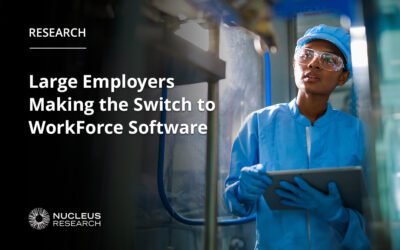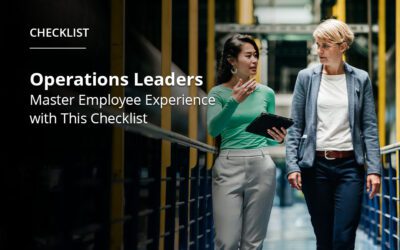How To Design Employee Experience Across Your Organization

Employees are the most valuable resource of any business and the key to unlocking prosperous longevity and overall success. That’s why rolling out an employee experience strategy that resonates and motivates is paramount for brands across all industries.
The Importance of Employee Experience
A Gallup survey on employee engagement found that businesses with a highly engaged workforce are 23% more profitable and 18% more productive than companies with less engaged associates.
Leaders must create strategies that improve employee experiences, especially for hourly, deskless shift workers. These frontline workers in industries like healthcare, manufacturing, public sector, natural resources, and retail are often forgotten by their employers, who tend to focus more on their deskbound employees.
Low-morale workplaces don’t need to lose workers to have a negative effect; discontented workers who stay can also cost the company. When employees lack engagement, it lowers productivity with frequent errors, missed deadlines, poor customer service, and lower profits. This spells further bad news for businesses because they risk losing valuable talent and are forced to invest time, money, and resources to source, hire, and train new staff.
To counter this, your employee experience strategy must be driven by collaboration, efficiency, and flexibility. This demand has become evident as employees have become more disillusioned with current practices. Leaders who are committed to finding ways to improve their employees’ work experiences by addressing their needs are more likely to hold on to top talent and boost revenue.
This article will guide you on how to effectively enrich your company’s employee experience, making your workforce more productive, engaged, and satisfied with their working environment.
Employee Experience is Everyone’s Responsibility
While employee experience strategies have traditionally been handled by Human Resource (HR) departments, they have evolved to be much more holistic. This means improving employee experiences must cut across all departments and touch on wide-ranging aspects—from attracting top talent and financial planning to managing risk and workforce planning.
While HR does play a central role in facilitating an excellent employee experience, it requires multiple divisions to achieve—IT, recruitment, and operations. It is a truly shared responsibility. Enhancing and elevating employee experience requires cross-departmental buy-in. All divisions must be aligned in terms of fostering a stimulating working environment that provides employees with the necessary tools and support systems they need to do their jobs effectively and efficiently.
Align the Workforce Experience with Company Values
Organizational culture should aim to create unique experiences for all employees informed by values. It is not to be confused with perks like free lunches or lounging areas. Values are central to the employee experience because they define how employees can and should work together. Employee experience begins with a clear understanding of the company’s culture and values, and businesses must ensure that it is aligned with their overall culture, mission, branding, and purpose.
When values are collective, they allow a team to share similar beliefs. These beliefs help individuals understand the purpose of their work, which in turn improves their performance. You can align employees’ personal journeys with your company values to leave your team happier and more productive in their roles.
For deskless shift workers in retail, fast food, public works, sanitation, and manufacturing, ensuring that they understand their contribution to their companies will create meaning and help them work with purpose to create a climate conducive to engagement.
Encourage Work-Life Balance
Our Third Annual Global Employee Experience Study shows employees crave more flexibility and autonomy. That’s why it is paramount for business to provide them with a healthy balance between their professional and personal lives.
One of the best ways for employers to give their employees a healthier work-life balance is to grant them appropriate control over their schedules.
Allow for Shift Swaps
Organizations can allow employees to swap their days off for another day within the week. This can also apply to multiple shifts within the same day. By allowing for shift swaps, employees can have better control over how they spend their days off.
Using modern employee scheduling software can help employees feel like they have more authority over how they spend their time, which significantly boosts morale.
Provide Paid Time Off (PTO)
Although not a Fair Labor Standards Act requirement, more and more businesses are offering PTO to their deskless shift workers. Additionally, getting paid time off is an effective employee experience strategy in getting workers to stay long-term.
Due to the nature of their jobs, many deskless shift workers operate on a “no work, no pay” basis. This can lead to unhealthy working conditions, with these workers still clocking in despite being ill. Paid time off will provide deskless shift workers the knowledge that their pay will not be docked when taking time off.
Understand Your Challenges through Pulse Surveys
Pulse surveys are quick—a few questions each—and when they occur regularly, offer an effective way to continuously gather feedback and measure engagement within your organization. Pulse surveys are generally reliable because they are quick and straightforward, leaving little room for fatigue, impatience, or other negative variables typical of long, annual surveys ensuring the quality and accuracy of the collected data.
Invest in Digital Employee Experience
When technology is integrated into employee experience, it enables employees to work more efficiently by providing real-time communication, accessibility to information (policy updates, guidelines, training materials), remote engagement, and performance management.
It would be wise for leaders to invest in workforce management technologies that make employee workflows more efficient and promote a positive employee experience while keeping data safe. They can address the gaps pointed out by deskless shift workers and provide them with tailor-made solutions that help make their jobs easier.
Employee Experience is About Every Employee, Every Day, and Everywhere Work Happens
Deskless workers are an integral part of the workforce. As industries continue to become more mobile, digital, and data-driven, these workers must be included in the evolution. For businesses to survive, they need to take on modern workplace strategies that embrace technology and allow all workers access to the tools they need from anywhere.
WorkForce Software solutions are designed to create great workplaces that span employee experiences that matter, resonate, and reverberate. Communication, connections, access, WorkForce Software delivers a breakthrough employee experience in the cloud, no matter how unique your employee needs are.
Schedule a demo today, and let WorkForce Software help you develop an employee experience strategy that enriches your organization’s employee experience!
Subscribe to The WorkForce Blog
Learn the art and science of maintaining productive, happy, engaged employees.
Discover More
Nucleus Insights from WorkForce Customers Research Note
Nucleus Research interviews WorkForce customers who validate why we’re ranked the #1 WFM enterprise vendor for 10 consecutive years.
Elevate Employee Experience: Checklist for Operational Leaders
Get the practical steps and technology functionalities operation leaders need to improve their employees’ work experiences.
Streamlining Complex Workforce Compliance Requirements Boosts Productivity
Discover how workforce compliance software helps EMEA organisations navigate complex legislation, enhance compliance and boost operational efficiency.



